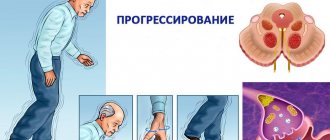One of the most common forms of dementia is Alzheimer's disease. An acquired neurodegenerative disease is characterized by the slow death of nerve cells and manifests itself as a persistent intellectual disorder. A person becomes unable to acquire new knowledge and skills, and also gradually loses previously acquired ones. In addition to memory impairment, problems arise with speech and spatial orientation. The patient loses the ability to care for himself, body functions go out.
When diagnosing, behavioral analysis, cognitive reactions, and MRI results are of great importance. Although a cure for Alzheimer's disease has not yet been found, there are ways to prevent its occurrence or reduce the severity of symptoms.
Predementia
The first stage of the disease, which is characterized by primary cognitive disorders. Typically, the patient’s most pronounced symptom is a deterioration in memory, namely short-term memory (it becomes increasingly difficult to remember information that was only recently memorized). This stage occurs 8-10 years before diagnosis. These symptoms are often confused with stress or the aging process.
- Services Prices
- Consultation with a psychiatrist-gerontologist 5000 rubles
- Calling a psychiatrist to your home for an elderly person 12,000 - 15,000 rubles
- Certificate of incapacity of an elderly person 5,000 rubles
- Initial consultation with a psychiatrist 5000 rubles
- Appointment with a psychiatrist, candidate of medical sciences, with 30 years of experience (50-60 min) 6,000 rubles
- Urgent call of a psychiatrist to your home (within the Moscow Ring Road) 12,000 - 15,000 rubles
- Psychiatric examination before the transaction (in the center) 5,000 rubles
- On-site psychiatric examination (60 min) 12,000 - 15,000 rubles
- Certificate of legal capacity when selling an apartment 5,000 rubles
- Conclusion on mental health 5000 rubles
Request a call back Make an appointment
Early dementia
This stage of diagnosis, as there is a further deterioration in the general condition of the patient: the symptoms are becoming more pronounced. In addition to short-term memory impairment, speech impairment, motor impairment, and the first symptoms of long-term memory impairment appear. Disorders of long-term memory manifest themselves individually in everyone, ranging from the inability to remember information that the patient memorized several years ago, ending with memories of the correct use of cutlery. There is a violation of the speech apparatus, however, it is hardly noticeable.
Moderate dementia
Memory problems only get worse, to the point of being unable to recognize your relatives. Manifestations of speech impairment become noticeably more noticeable - as the disease progresses, a decrease in vocabulary occurs; Often the patient begins to select the wrong words to replace the forgotten ones. Loss of motor coordination occurs, and it becomes increasingly difficult to perform everyday tasks. There is a loss of reading and writing skills, disturbances in the patient’s psycho-emotional state, outbursts of aggression and spontaneous crying.
Classification of the disease
Throughout the disease, a pattern of progressive disorders is observed. According to symptoms, there are four stages of Alzheimer's: predementia, early, moderate and severe. Slow degradation occurs over an average of 7 years, ending in the death of the patient.
Initial stage (pre-dementia)
The first manifestations of Alzheimer's disease, such as memory impairment and lack of concentration, are mistakenly perceived by relatives as manifestations of aging. Problems with the performance of everyday functions are still barely noticeable. It is typical that already at this time the person becomes apathetic, which persists throughout the disease.
Early stage
Memory continues to decline. The patient retains clear consciousness and high sensitivity, but the ability to normally perceive information is lost. For example, a person does not recognize or partially recognizes familiar faces. Or he cannot determine which objects in his environment have the same color. Clumsiness in performing daily tasks appears, fine motor skills are impaired. With some manipulations, the patient requires help, although he can still do many things on his own.
Moderate stage
The condition is worsening, as evidenced by obvious speech impairments. To replace a forgotten word, a person often selects the wrong words. Consistent movements are difficult. Most everyday tasks require significant effort. Psychiatric deviations appear, for example, the idea of vagrancy. Irritability can come and go quickly. Symptoms of delirium often occur. The person becomes whiny. It happens that he resists help. In order to smooth out the increase in general stress, relatives often move the sick person to a hospital for care.
Severe stage
At this stage, the patient cannot live without outside help. He is able to pronounce individual words and phrases, understands other people's speech and can show emotions. The condition is characterized as apathetic, exhausted. In the end, even small actions are impossible without the participation of others.
Based on its form, Alzheimer's disease is divided into presenile and senile. The first is a disease detected before age 65. The senile form refers to patients older than this age. Presenile dementia is characterized by rapid progression, family history, and rapid impairment of speech functions. The pace of progress depends on the standard of living, type of activity, heredity, and the presence of chronic diseases.
Senile dementia develops slowly at first. The first stages last 2-4 years. Temporary improvements in condition are characteristic. An elderly patient remembers the past perfectly, but does not perceive new knowledge. As it progresses, false memories arise, and people from the current environment are associated with people from their youth. There is no complete breakdown of speech. On the contrary, a sick person can speak vividly to the end and retain a rich vocabulary.
Causes
The exact causes of the disease are not known. Previously, it was thought that the main cause was a disruption in the production or massive destruction of the neurotransmitter acetylcholine. However, drugs based on it did not cure the patient. The following possible reasons are currently identified:
- Genetic predisposition;
- Heavy metal poisoning;
- Head injuries;
- Hypothyroidism;
- Malignant and benign neoplasms;
- Concomitant genetic diseases (Down syndrome);
- Age.
Causes of the disease
Doctors have not yet achieved a complete understanding of the cause of Alzheimer’s and the course of the disease. Apparently, the whole point is the accumulation of peculiar protein deposits in the brain tissue, which are recorded using computer, magnetic resonance and other types of tomography.
The main risk factor is old age. If under the age of 70 Alzheimer's disease is registered in three cases per 1000 people, then in 80-year-olds it is already up to 20 cases, and in 90-year-olds it is 70 cases per 1000 people. The disease is extremely rare in people under 60 years of age. Elderly women get sick more often than men.
Doctors attach great importance to genetic predisposition. A defective gene leading to the appearance of forms of proteins with neurotoxic properties was found in 50% of patients.
According to doctors, other reasons can serve as the impetus for the onset of the disease:
- brain injuries and concussions;
- psychological disorders;
- vascular problems;
- regular alcohol intake, nicotine addiction;
- obesity;
- low intellectual activity.
In patients diagnosed with Alzheimer's, after autopsy, so-called senile plaques are discovered - spherical extracellular foci of brain damage, which have negative consequences on the nervous system and brain functions.
Risk group
Patients who have certain diseases are automatically included in the risk group. These diseases can be grouped together according to one very important symptom - lack of oxygen in brain cells:
It is also worth mentioning separately about the disturbance of protein metabolism, or more precisely about the production of a pathological protein - amyloid. It can be deposited in the brain in the form of plaques and leads to neuronal degeneration and impaired blood supply. A distinctive feature of this protein is that the body is unable to dissolve it or get rid of it on its own. This protein begins to be deposited long before the first symptoms of the disease appear.
Disease of the 21st century
In this article we will talk about the most important things about Alzheimer's syndrome, reducing as much as possible "commonplaces"
The German psychiatrist Aloys Alzheimer (1864–1915) published numerous scientific papers, but was best known for his famous lecture on an “unusual disease of the cerebral cortex” in 1906. Alois was investigating a condition in a 50-year-old woman that caused memory loss, disorientation, hallucinations and ultimately led to death at the age of 55. An autopsy showed that the patient's cerebral cortex was thinner than usual, senile plaques were detected in the extracellular space, and neurofibrillary tangles were detected inside neurons. Alois's colleague Emil Kraepelin called the disease Alzheimer's disease. The morphological criteria for AD described by Alois have remained unchanged to this day. From history, let's now move on to the actual medical aspects of the syndrome.
Prevalence
According to WHO, asthma is one of the most common diseases among older people, causing more than half of the cases of dementia and ranking 4th among the causes of death in developed countries of the world. Researchers from Johns Hopkins University estimated that in 2006 there were 26.6 million patients with asthma in the world, and in 2050 the number of patients will increase to 106.8 million. The older a person is, the more likely it is to develop this disease. If at 65–69 years old 2–5% of people suffer from it, then after 85 years this percentage reaches 30–40. Thus, “aging” countries are doomed to an “epidemic” of asthma and increased costs of maintaining patients.
Everyone suffers from Alzheimer's syndrome - both ordinary people and world-famous ones. For example, former US President Ronald Reagan, Irish writer Iris Murdoch, former British Prime Minister Margaret Thatcher, actor Peter Falk, English writer Terry Pratchett and a number of other celebrities have been or are now diagnosed with Alzheimer's disease.
https://ru.wikipedia.org/wiki/Alzheimer's Disease#cite_note-215
Etiology and Pathogenesis
The etiology of the disease still remains unclear, which is especially true for the non-hereditary (sporadic) form of AD. Against the background of natural aging processes, events specific to Alzheimer's syndrome unfold, the central ones being the deposition of α-amyloid in the cortex and hippocampus (Selkoe, 1994) and the maturation of senile plaques. This causes a cascade of molecular changes that lead to dysfunction and death of nerve cells such as apoptosis or necrosis, which is clinically expressed as progressive dementia. Cholinergic deficiency, oxidative stress, and increased levels of proinflammatory cytokines and glutamate (an excitatory neurotransmitter) occur in brain tissue.
The discovery of causative mutations in the amyloid precursor protein and presenilin genes (b-APP, PSEN-1 and) concerns very rare families with autosomal dominant forms of the disease, the so-called pedigree familial Alzheimer's disease, which affects 50% of each generation, regardless of gender , between 30 and 50 years. Mutations in the PSEN-2 gene are characterized by incomplete penetrance (i.e., they do not always lead to the development of AD); they are responsible for the development of rarer, both early and late, familial forms of the disease.
A study of pedigrees of non-familial forms of AD gives the following result: on average, the risk of developing AD for first-degree relatives is 3–14%. At the same time, studies of twins have shown a significant (but not 100%) role of genetic factors. The concordance rate for monozygotic twins (85%) is significantly higher than for dizygotic twins (42%).
Symptoms of Alzheimer's disease
There are 2 forms of asthma: presenile (with onset before 65 years of age) and senile (with onset after 65 years of age). It is extremely rare that AD can debut at the age of 30 (usually due to a mutation in the presenilin-1 gene). The disease develops asymptomatically for some time - the brain manages to compensate for the loss of damaged neurons. The clinic appears, perhaps years after the launch of the pathogenetic mechanism. An early, although not sufficiently specific, sign of Alzheimer's disease can be atrophy of the medial parts of the temporal lobes, primarily the hippocampus, detected by magnetic resonance imaging. Neuropsychological screening testing can help in diagnosing AD, in which patients copy figures, memorize words, read, and perform arithmetic operations. Differential diagnosis is primarily carried out with vascular dementia.
Risk factors for asthma currently include:
- age
- female gender (women have the disease twice as often as men)
- history of traumatic brain injury, myocardial infarction, hypothyroidism, depression, exposure to electromagnetic fields
- low serum levels of vitamin B12 and folate
- smoking
- heavy metal poisoning
- long-term use of NSAIDs
- hormone replacement therapy (HRT)
- age of the mother at the time of the individual's birth
- complete abstinence from or abuse of alcohol
The following factors are considered protective:
- intellectual work, high level of education
- daily consumption of tea and coffee
- moderate alcohol consumption
Life expectancy for patients from diagnosis averages 6–8 years, but can vary from 2 to 20 years. Less than 3% of patients survive more than fourteen years. The first symptom of Alzheimer's disease is memory loss. Memorization of new material suffers first, and professional memory is the last to be impaired. Efficiency decreases, the range of interests narrows, pronounced emotional lability, anxiety, suspiciousness and some disinhibition appear.
Later, speech disorders appear. First of all, the understanding of spoken speech suffers, but the ability to repeat words and sentences remains for a long time. In addition, patients find it difficult to name objects. The skill of meaningful verbal communication is gradually lost, and echolalia, palilalia, or mutism may occur. Praxis, gnosis and other cognitive functions are progressively impaired, personality changes, and affective disorders and psychoses (hallucinations, delusions) may develop.
Echolalia is an uncontrolled automatic repetition of words heard in someone else's speech.
Pallilalia is a person’s painful need to repeat certain words or sentences.
Mutism is a refusal of speech communication in the absence of organic lesions of the speech apparatus.
In the final stage, patients lose the ability to self-care, are disoriented in space and time - in fact, completely retarded. Neurological symptoms are common: impaired walking, rigidity, bradykinesia, myoclonus, seizures, spastic paraplegia with flexion contracture of the legs. At the terminal stage, due to hypokinesia, patients may develop sepsis, urological inflammatory diseases, aspiration pneumonia, which can be a direct cause of death. Unfavorable prognostic factors that may indicate rapid development of the disease: extrapyramidal disorders (rigidity, bradykinesia, hypomimia, rest tremor, as well as walking disorders - shuffling gait, acheirokinesia, difficulty turning).
In patients with the presenile type of the disease, the main personal characteristics are preserved for a long time, there is a feeling of one’s own inferiority or change and an adequate emotional response to the disease. Typically, the disease develops slowly at the initial stage and rapidly progresses at the stage of clinically significant dementia. They are also characterized by the presence of rich neurological symptoms.
Stages of Alzheimer's disease
Regardless of the type of asthma, three stages are distinguished:
At the stage of mild dementia, the patient
- realizes memory impairment, suffers from it, writes down important facts.
- has difficulty in counting and writing, generalizes, compares and makes judgments worse
- irritable and impulsive; typical “Alzheimer's amazement”: eyes wide open, face mask of surprise, blinking infrequently.
- gets sloppy
- has stereotypical movements
- gets confused in an unfamiliar environment, for example, in a hospital during hospitalization, they have difficulty staying in their ward
- maintains the ability to self-care at home
Approximately a quarter of patients at this stage have delusional disorders in the form of episodic delusional ideas of damage, theft, and less often - ideas of relationship, persecution or jealousy.
At the stage of moderate dementia, the patient
- ceases to be aware of memory and thinking disorders
- has difficulty reproducing past knowledge, forgets to shave, dress, wash,
- has speech, praxis and gnosis disorders; in particular, he confuses the right and left sides, cannot name parts of the body, ceases to recognize himself in the mirror, changes his handwriting and the nature of his signature.
- has stereotypical picking movements, in bed stereotypically covers his head or makes “rummaging” movements.
- disoriented in time and often in the environment
- can only do simple housework, so constant support and assistance is needed even with self-care.
- may complain of headaches, dizziness and nausea (a manifestation of hydrocephalus)
- loses weight with preserved and even increased appetite.
- sometimes he leaves home, forgetting the way back, his first and last name, year of birth, and does not predict the consequences of his actions. The period of disorientation is replaced by relative preservation of memory. Such an acute and paroxysmal course indicates the presence of a vascular component.
- may have seizures and short-term episodes of psychosis. When associated with a somatic pathology, such as pneumonia, he may fall into delirium.
At the stage of severe dementia, the patient
- totally weak-minded, has complete fixation amnesia and almost complete disorientation in time and space
- has a poor understanding of his own personality
- practically incapable of judgment and inference and verbal communication
- has increased muscle tone, lies in a “fetal” position
- dies in a state of vegetative coma or from associated infections against the background of progressive cachexia.
Treatment of Alzheimer's disease
Unfortunately, today there is no treatment that could prevent or significantly slow down the progression of asthma. Here are the main areas of therapy and medications.
1. Replacement therapy: a) acetylcholinesterase inhibitors (Donepezil and its generic Alzepil, Galantamine hydrobromide, Rivastigmine, Ipidacrine) compensate for the cholinergic deficiency to reduce the severity of the main symptoms b) antiglutamate drugs (non-competitive reversible antagonist to glutamate Memantine) - normalize glutamate metabolism in the brain. When a satisfactory therapeutic result is achieved, the drug is left indefinitely - usually for life. Both acetylcholinergic drugs and Memantine contribute to the regression of the main symptoms of dementia: cognitive, behavioral, psychotic and functional disorders. Acetylcholinesterase inhibitors and Memantine act on different “targets” and do not form drug interactions, so they can be prescribed simultaneously. Combination therapy is most appropriate if monotherapy is insufficiently effective.
2. Neuroprotective therapy helps keep neurons viable and should be used in the early stages of the disease. They use: a) antioxidants (vitamin E, ginkgo biloba extract) - more effective at the pre-dementia stage b) drugs with neurotrophic properties (cerebrolysin) c) neuroprotectors (nicergoline)
3. Methods of neuropsychological rehabilitation are aimed not only at developing the defective function, but also at bypassing, “bypassing” the existing defect and reducing its impact on the patient’s daily life. Firstly, this is training in mnemonic and mediating techniques, a recording system, breaking a complex task into a number of elementary ones, verbal regulation of one’s actions, etc. Secondly, this is training in regulatory cognitive functions (develops the ability to switch from one task to another, slow down inadequate impulsive reactions, planning actions for the immediate and long term, solving complex financial problems). In addition, additional sensory stimulation of patients can be used: music therapy, phototherapy, aromatherapy, therapeutic exercises. Combined drug and non-drug treatment provides more reliable and long-lasting results in the treatment of patients with asthma.
The use of nootropics (piracetam, pyriditol) - drugs that improve cerebral metabolism - has not yielded reliable positive results in the treatment of patients with asthma. The use of large doses often leads to rapid progression of dementia (after a short-term improvement in cognitive function). This effect is explained by neurotransmitter depletion of cholinergic structures after their excessive stimulation with large doses of nootropics.
Gavrilova S.I., Zharikov G.A. Treatment of Alzheimer's disease // Psychiatry and psychopharmacotherapy Volume 3/N 2/2001
(https://old.consilium-medicum.com/media/psycho/01_02/45.shtml)
4. New trends in AD therapy Today, NSAIDs are being used to treat Alzheimer's syndrome. A small clinical trial of indomethacin showed that asthma patients treated with indomethacin for 6 months showed stabilization, while patients treated with placebo showed deterioration in a number of parameters over this period. In addition, the results of clinical trials published in 2004 by the National Institutes of Health (NIH) of selective COX-2 inhibitors (rofecoxib, celecoxib) showed that they also have a protective effect and at the same time produce fewer adverse events, than non-selective ones. It is not yet possible to say whether selective NSAIDs will be as effective in asthma as non-selective ones.
Hormone replacement therapy is a proven protective factor against the development of asthma, but it can have a number of serious complications (thrombotic and oncological). The safety and effectiveness of HRT for asthma is currently being tested. Anti-amyloid treatment strategies are currently under development. They are developing in two main directions. The first of them is aimed at neutralizing the neurotoxic properties of b-amyloid deposits through the introduction of special ligands or proteases. The second is to reduce the production of b-amyloid due to inhibitors of amyloid synthesis enzymes.
Gavrilova S. I. Alzheimer's disease: new therapeutic options // Psychiatry and psychopharmacotherapy Volume 6/N 2/2004 https://old.consilium-medicum.com/media/consilium/04_02/142.shtml Levin O. S. Diagnostics and treatment of dementia in clinical practice, 2010 Topolyansky A.V., Borodulin V.I. Syndromes and symptoms in clinical practice: eponymous dictionary reference book, 2010 Salloway S, Mintzer J, Weiner MF, Cummings JL. Disease-modifying therapies in Alzheimer's disease. // The Journal of the Alzheimer's Association, Volume 4, issue 2 (March, 2008), p. 65–79 https://citeseerx.ist.psu.edu/viewdoc/download?doi=10.1.1.176.168&rep=rep1&type=pdf https://www.nih.gov/news/pr/dec2004/od-20. htm
Symptoms
Each stage is characterized by certain symptoms. The early stage is characterized by:
The late stage is characterized by:
These are common symptoms that in most cases appear in all patients. However, we must remember that individual symptoms are also possible. For example: repetition of phrases, fear and anxiety when faced with difficulties.
Attention! We must remember that all these symptoms and the patient’s future lifestyle will lead to a decrease in immunity, which means complications such as:
It is very important to consult a doctor when the first symptoms of the disease appear. It is also important to undergo preventive medical examinations for early detection of the disease.
Diagnostics
It is very difficult to recognize the disease, since when diagnosing one has to rely on symptoms and complaints - in the early stages it is very difficult to differentiate the disease from stress or from the processes of physiological aging. And in most cases, the patient does not immediately turn to a specialist, since the symptoms may not bother him much. In the later stages, the diagnosis is easier to make – the characteristic symptoms become more pronounced. But it is worth remembering that other diseases can manifest themselves similarly:
- Stroke;
- Parkinson's disease;
- Atherosclerosis of cerebral vessels;
- Neoplasms of the brain.
For correct diagnosis, it is very important for the doctor to collect a complete medical history of the patient:
- When did the first symptoms appear?
- What symptoms does the patient have?
- How severe are the symptoms?
- Accompanying illnesses;
- Presence of injuries.
Due to the nature of the course of the disease, the patient cannot always independently answer all the doctor’s questions, so making a diagnosis can be difficult. If possible, all the necessary information is provided to the doctor by knowledgeable relatives of the patient.
Diagnosis also includes neuropsychological tests, which help assess the severity of cognitive impairment, and PET scans, which are used to detect amyloid accumulations in the brain.
Signs of the last stage of Alzheimer's
The last stage of Alzheimer's disease is characterized by complete degradation of personality, the patient can no longer care for himself, reflexes are impaired, he cannot swallow food, and loses speech. The last stage of the disease confines a person to bed - the patient cannot raise his head, stops smiling, there is increased muscle tone, and the person experiences severe pain. This stage of the disease ends in death.
At the last stage of Alzheimer's disease, the patient needs help with everything - he cannot use the toilet on his own, there is urinary incontinence, he may have trouble finding his way around the apartment. At the last stage of the disease, the use of adult diapers and round-the-clock supervision of the patient are required. In most cases, the patient's relatives find a caregiver or place him in a boarding school or boarding house for patients with dementia. Medical documents (examination results, expert opinions) for placement in a boarding house or boarding school can be prepared by a specialist from the Yusupov Hospital.
Living with such a patient becomes a very difficult test for relatives. The patient behaves inappropriately, may be aggressive, hit, scream, refuse food or hygiene procedures. During the severe stages of Alzheimer's disease, a lot of time is required to care for the sick person. Often, family members who have a patient with dementia suffer from depression and experience chronic stress.
Specialists at the Yusupov Hospital help the patient’s relatives - they are assisted by a psychologist, and qualified hospital staff teach how to care for the patient. In the hospital you can undergo rehabilitation activities and receive timely medical care. Make an appointment with a neurologist by phone. After the examination, the doctor will prescribe the necessary diagnostic methods and select the optimal therapy.
Differential diagnosis
To carry out differential diagnosis, a biochemical study of the patient’s blood is performed to exclude all possible inflammatory diseases. In the early stages of the disease, you can perform a CT or MRI to exclude the possibility of tumors in the brain and stroke, and angiography to look at the patency of blood vessels and the presence of atherosclerosis. Psychological tests are used to identify specific organic thinking disorders and to determine concomitant depression, anxiety, and other symptoms that may aggravate the course of dementia.
At later stages, CT and MRI will show significant brain atrophy in characteristic areas. It is also advisable to conduct a chemical analysis of the cerebrospinal fluid to detect pathological or disease-specific cellular elements in it. Genetic analysis will determine predisposition to this disease, as well as detect mutations characteristic of Alzheimer's disease.
How long do they live with adequate treatment for Alzheimer's disease?
Alzheimer's disease comes in senile and presenile forms. The senile (senile) form of the disease occurs in people over 65 years of age, progresses slowly, the patient can live up to 80 years with adequate treatment. In this form of the disease, the main symptom is memory loss; in the initial stages, disturbances in thinking and speech are weak.
The presenile form of the pathology occurs at a younger age - in people over 40 years of age. With this form of the disease, the cause is most often heredity. The presenile form of the disease is characterized by rapid progression of the pathology; complete personality degradation occurs within a few years. The life expectancy of patients with adequate treatment is from 7 to 10 years.
Drug treatment
All drugs prescribed by doctors are aimed at relieving the symptoms of the disease:
- The use of antioxidants improves blood supply to the brain, hemodynamics and reduces cholesterol levels (preventing the development of atherosclerosis);
- Prescribe drugs that improve thought processes and memory;
- Antidepressants are introduced into the course of treatment to maintain psycho-emotional balance;
- Cholinesterase inhibitors reduce the rate of destruction of neurotransmitters, and thereby increase their concentration in the brain;
- Antipsychotics help reduce aggression and stop psychosis (however, according to statistics, long-term use of these drugs increases mortality);
- Beta-secretase inhibitors – reduce amyloid synthesis and the creation of amyloid plaques.
Treatment
Today, treatment for Alzheimer's disease is aimed at combating symptoms and improving the quality of life of patients.
It is important to start treatment in a timely manner!
Cholinesterase inhibitors. The following drugs are used to combat acetylcholine deficiency:
- acetylcholine precursors (citicoline, choline alfoscerate);
- promoting the release of acetylcholine in the synapse (ipidacrine);
- capable of enhancing the effect of acetylcholine (galantamine);
- blocking the breakdown of acetylcholine (rivastigmine, donepezil, galantamine, ipidacrine);
Memantine is the only drug recommended worldwide for the treatment of dementia due to Alzheimer's disease. Can be used for moderate to severe cases.
Cerebrolysin – believed to increase brain cell viability.
All drugs can have significant side effects and have strict contraindications, so the dosage regimen is selected individually by the doctor. It is also impossible to supplement the treatment regimen with nootropics in order to support the brain on your own.
Psycho-emotional intervention
Used as an additional method. The general condition does not improve, however, individual problems such as incontinence may be alleviated. This therapy helps patients adapt to the disease. In the early stages, memory therapy is carried out: patients discuss the events they have experienced, using photographs, objects, favorite music, videos and other well-known objects. However, this method affects the patient individually. The method of simulating presence is based on attachment theory: audio and video recordings with the voices of family and friends are used. In patients undergoing this therapy, feelings of anxiety decrease and behavior becomes calmer. Stimulating methods include music therapy, art therapy, communication with animals, and physical exercise, which have a positive effect on behavior and mood.
Patient care
Relatives have the hardest time. It is important to realize that a loved one is becoming more and more helpless and to understand that the patient’s behavior is provoked by an illness. The key to success is patience with the patient. It is necessary to create safety, proper nutrition, prevent bedsores and maintain immunity, and try to provide complete protection from stressful situations. Doctors recommend making an appointment with a psychologist, since in the life of a person caring for a patient, as a rule, psycho-emotional disorders, depression, and social and economic problems arise. As the disease progresses, the patient will experience various complications, such as diseases of the teeth and oral cavity, impaired ability to feed independently (later problems with swallowing food), respiratory diseases, eye and skin infections, etc. It is imperative to monitor the general somatic condition of the patient and at the first manifestation of problems, urgently look for solutions. Monitor the patient’s hygiene independently, including brushing teeth after each meal. Grind the food or turn it into a mushy state (if necessary, feeding is done through a tube). If necessary, restrain the patient to prevent harm to themselves or others.
Prevention of Alzheimer's disease
Unfortunately, since this is a progressive and incurable disease, prevention is ineffective and is aimed at increasing immunity and reducing the signs of the disease:
- Diet;
- Prevention of cardiovascular diseases;
- Intellectual loads;
- Getting enough vitamins;
- Fighting bad habits;
- Physical exercise;
- Fighting obesity.
Some foods should be included in the diet, as they have useful and necessary properties: fruits, vegetables, cereals, olive oil, red wine, grapes (namely seeds), cinnamon, coffee. Some of these foods have anti-amyloid properties, while others contain optimal amounts of essential nutrients and minerals.
Preventive actions
Preventive, that is, prophylactic measures, can slow down the development of the disease, but whether it can be prevented, scientists do not have a consensus.
To prevent Alzheimer's disease, it is recommended for older people to:
- lead an active life;
- be interested in new electronics;
- master the computer and use of gadgets;
- stimulate brain activity, read, find new hobbies.
Moderate physical exercise, especially outdoors, is very beneficial. At this time, the blood is saturated with oxygen, the brain structures begin to function better, which reduces the risk of vascular disorders.
When cardiovascular and pulmonary diseases are detected, it is important to treat them promptly. Normal organ function prevents the development of Alzheimer's type dementia.
Alzheimer's analogues
Hackebusch-Heuer-Geimanovich disease (syndrome) is an “Alzheimer-like” picture that develops as a result of atherosclerotic lesions of cortical vessels joining the senile-atrophic process.
Psychotic forms of senile dementia represent a heterogeneous group. The belonging of most observations to senile dementia is beyond doubt. These are affective, paranoid, hallucinatory, confabulatory psychoses that last for 1–3 years, developing at a late age, usually following a personality shift, reminiscent of the initial stage of senile dementia. After a gradual reduction of psychotic symptoms, dementia slowly increases, more or less close to senile. Such variants of senile dementia usually develop as a result of a special combination of factors: constitutional-genetic (hereditary burden of endogenous psychoses and the schizothymic personality of patients) and the relatively weak progression of the atrophic process. There are also cases that are less unambiguous in nosological terms, namely, chronic psychoses manifesting in old age, and sometimes in the involutionary period, developing according to the laws of continuously occurring schizophrenia. Usually these are hallucinatory-delusional psychoses with stabilization of the clinical picture at the paraphrenic stage - first at the fantastic-hallucinatory stage, and then at the confabulatory stage. Rare cases of chronic catatonia are also possible. The development of such psychoses is accompanied by personality changes: autism, isolation, inactivity. After a very slow reverse development of psychotic disorders (after 5 - 10 years or more), mnestic-intellectual disorders are discovered, which, however, do not reach significant depth. The relationship of these cases to the main form of senile dementia remains unclear; perhaps (taking into account their frequent hereditary burden with schizophrenia), they represent special age-related psychoses (with phenomena of increased mental aging) in a schizophrenic family circle.
- Services Prices
- Consultation with a psychiatrist-gerontologist 5000 rubles
- Calling a psychiatrist to your home for an elderly person 12,000 - 15,000 rubles
- Certificate of incapacity of an elderly person 5,000 rubles
- Initial consultation with a psychiatrist 5000 rubles
- Appointment with a psychiatrist, candidate of medical sciences, with 30 years of experience (50-60 min) 6,000 rubles
- Urgent call of a psychiatrist to your home (within the Moscow Ring Road) 12,000 - 15,000 rubles
- Psychiatric examination before the transaction (in the center) 5,000 rubles
- On-site psychiatric examination (60 min) 12,000 - 15,000 rubles
- Certificate of legal capacity when selling an apartment 5,000 rubles
- Conclusion on mental health 5000 rubles
Request a call back Make an appointment









